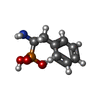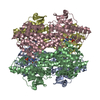+Search query
-Structure paper
| Title | Engineered Phenylalanine Ammonia-Lyases for the Enantioselective Synthesis of Aspartic Acid Derivatives. |
|---|---|
| Journal, issue, pages | Angew Chem Int Ed Engl, Vol. 63, Issue 31, Page e202406008, Year 2024 |
| Publish date | Jul 29, 2024 |
 Authors Authors | Ivan Buslov / Sarah Desmons / Yoan Duhoo / Xile Hu /  |
| PubMed Abstract | Biocatalytic hydroamination of alkenes is an efficient and selective method to synthesize natural and unnatural amino acids. Phenylalanine ammonia-lyases (PALs) have been previously engineered to ...Biocatalytic hydroamination of alkenes is an efficient and selective method to synthesize natural and unnatural amino acids. Phenylalanine ammonia-lyases (PALs) have been previously engineered to access a range of substituted phenylalanines and heteroarylalanines, but their substrate scope remains limited, typically including only arylacrylic acids. Moreover, the enantioselectivity in the hydroamination of electron-deficient substrates is often poor. Here, we report the structure-based engineering of PAL from Planctomyces brasiliensis (PbPAL), enabling preparative-scale enantioselective hydroaminations of previously inaccessible yet synthetically useful substrates, such as amide- and ester-containing fumaric acid derivatives. Through the elucidation of cryo-electron microscopy (cryo-EM) PbPAL structure and screening of the structure-based mutagenesis library, we identified the key active site residue L205 as pivotal for dramatically enhancing the enantioselectivity of hydroamination reactions involving electron-deficient substrates. Our engineered PALs demonstrated exclusive α-regioselectivity, high enantioselectivity, and broad substrate scope. The potential utility of the developed biocatalysts was further demonstrated by a preparative-scale hydroamination yielding tert-butyl protected l-aspartic acid, widely used as intermediate in peptide solid-phase synthesis. |
 External links External links |  Angew Chem Int Ed Engl / Angew Chem Int Ed Engl /  PubMed:38713131 PubMed:38713131 |
| Methods | EM (single particle) |
| Resolution | 2.17 Å |
| Structure data | EMDB-19897, PDB-9eq5: |
| Chemicals |  ChemComp-PPH: |
| Source |
|
 Keywords Keywords | LYASE / Phenylalanine catabolism Lyase |
 Movie
Movie Controller
Controller Structure viewers
Structure viewers About Yorodumi Papers
About Yorodumi Papers





 Rubinisphaera brasiliensis DSM 5305 (bacteria)
Rubinisphaera brasiliensis DSM 5305 (bacteria)